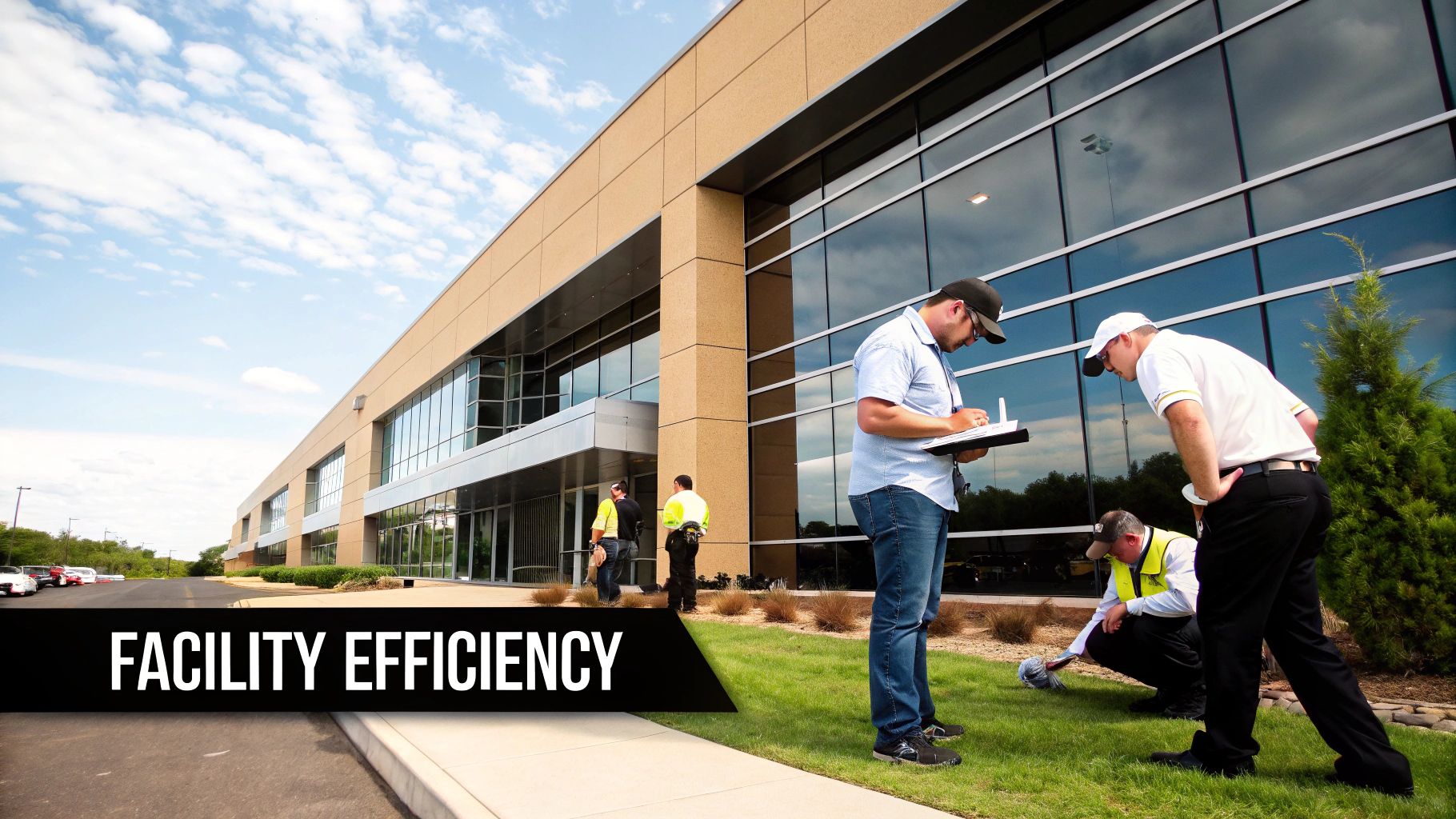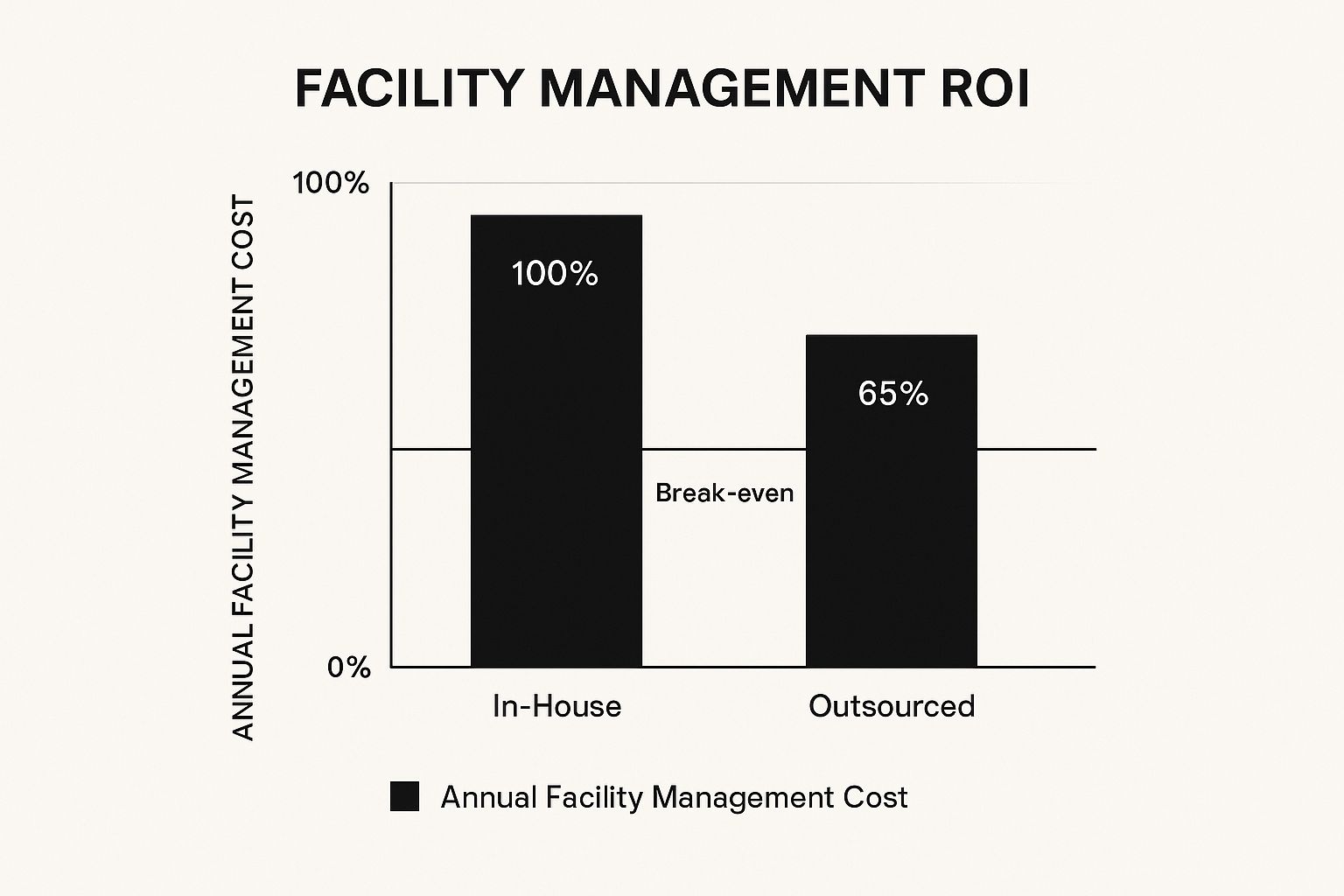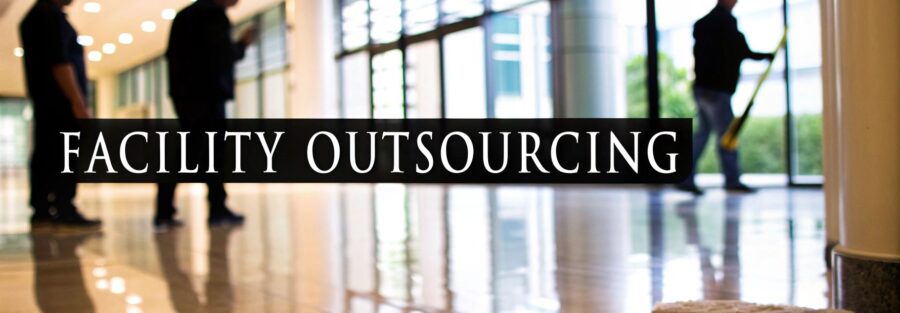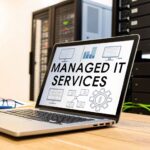Why Outsourcing Facility Management Is Transforming Business

Facility management is no longer a simple operational task; it's a crucial element for business growth. Companies focused on the future are understanding the significant advantages of outsourcing facility management to gain a competitive advantage. Several key factors drive this change, including globalization, advancements in technology, and the increasing difficulty of managing modern workplaces.
From Cost Center to Strategic Enabler
Facility management has traditionally been seen as a cost center. However, outsourcing facility management is shifting this perspective. By working with specialized providers, businesses can make their facility operations more efficient, lower overhead, and free up internal staff. This allows them to focus on their core business activities.
For instance, outsourcing services like maintenance, cleaning, and security allows internal teams to dedicate more time to crucial areas. These can include product development, sales, and customer service. This strategic shift in resources can lead to greater productivity and better overall business performance. Plus, outsourcing gives access to specialized skills that might be challenging or costly to maintain internally.
Furthermore, the facility management services market is expanding rapidly, largely due to the rise in outsourcing. The market is expected to grow from $1,744.37 billion in 2024 to $1,981.61 billion in 2025, with a CAGR of 13.6%. Factors like globalization, the increasing practice of outsourcing, and a growing emphasis on sustainability and energy efficiency contribute to this expansion. This trend of outsourcing non-core functions allows businesses to improve efficiency and concentrate on their core strengths. Learn more about this growing market in this report. Consider outsourcing your website development to free up your team to focus on your main business objectives.
Embracing Scalability and Innovation
Outsourcing facility management offers businesses more scalability and flexibility. As companies expand or downsize, their facility requirements evolve. An outsourced provider can readily adjust to these changes, ensuring that facilities are the right size and optimized for current operational needs.
This adaptability allows businesses to respond effectively to market shifts. It also helps them avoid the expenses and difficulties associated with managing in-house facility teams during periods of rapid growth or downsizing.
Moreover, outsourcing facility management opens doors to innovation. Specialized providers are often leaders in adopting new technologies and best practices. These can be in areas such as energy efficiency, sustainability, and smart building management. By tapping into this expertise, businesses can enhance their facility performance, minimize their environmental impact, and create more effective and engaging workspaces.
Unlocking the Real Benefits Beyond Cost Savings

The infographic above illustrates the cost differences between in-house facility management and outsourcing, including the return on investment (ROI) timeline. Outsourced facility management can significantly lower annual costs to 65% compared to 100% for in-house management, reaching break-even within 12 months. This highlights the financial benefits of outsourcing in a short period.
While cost reduction is a key motivator, outsourcing facility management offers numerous advantages beyond initial savings. These lead to noticeable operational enhancements and create lasting value for businesses of all sizes, allowing companies to reallocate resources and concentrate on core business goals.
To illustrate the key differences between these two approaches, let's examine a detailed comparison:
In-House vs. Outsourced Facility Management: The Real Comparison
This comprehensive comparison reveals the practical differences between traditional in-house facility management and strategic outsourcing partnerships across critical business dimensions.
| Business Impact | Traditional In-House Approach | Strategic Outsourcing Partnership | Competitive Advantage |
|---|---|---|---|
| Cost | 100% of budget | 65% of budget | Significant cost reduction |
| Expertise | Limited to in-house staff skills | Access to specialized expertise | Improved service quality and efficiency |
| Scalability | Difficult and time-consuming | Flexible and adaptable to changing needs | Enhanced responsiveness to market demands |
| Innovation | Dependent on internal resources | Access to industry best practices and new technologies | Continuous improvement and operational optimization |
| Focus | Divided between core business and facility management | Core business focus enabled | Increased productivity and strategic advantage |
This table summarizes the core distinctions between in-house and outsourced facility management. Outsourcing offers a competitive edge by reducing costs, providing specialized expertise, enhancing scalability, and driving innovation. This allows businesses to focus on their core strengths, leading to increased efficiency and strategic growth.
Accessing Specialized Expertise
One major advantage of outsourcing is access to specialized expertise that may be difficult or expensive to maintain internally. Outsourcing providers offer extensive knowledge and experience in various facility management areas, from maintenance and security to energy management and sustainability. For example, a specialized provider can implement advanced energy-saving techniques that an internal team might lack the resources or expertise to implement. This results in immediate cost savings and supports long-term sustainability objectives.
Outsourcing providers often employ highly trained professionals equipped to manage diverse tasks, eliminating the need for companies to invest heavily in internal staff training. This expertise ensures efficient operations and minimizes the risk of costly errors or disruptions.
Enhanced Scalability and Flexibility
Outsourcing also delivers improved scalability and flexibility, allowing businesses to quickly adjust to changing needs. During growth periods, providers can rapidly scale services to meet increased demands without the complexities of internal hiring and training. During downsizing, services can be adjusted to align with reduced requirements, easing the challenges of layoffs and internal team restructuring.
This adaptability enables companies to effectively respond to market fluctuations and maintain optimal facility performance regardless of economic conditions. It provides the right level of support at any given time, a significant advantage in today's dynamic business environment.
Driving Continuous Improvement
Leading businesses use outsourcing to access innovation and industry best practices. Facility management providers constantly explore new technologies and strategies to optimize services. They share this knowledge with clients, promoting continuous improvement often beyond what internal teams can achieve.
For instance, a provider might implement AI-powered predictive maintenance solutions to identify potential equipment issues before they arise, minimizing downtime and boosting operational efficiency. This proactive approach reduces costs and enhances overall facility performance and reliability, contributing to a more resilient and future-ready organization.
Industry-Specific Approaches That Actually Work

Outsourcing facility management isn't a one-size-fits-all approach. Different industries have unique needs, and the most effective strategies are tailored to address specific challenges. A manufacturing plant, for instance, will have different requirements than a hospital or an office building. Let's explore how various sectors are using customized facility management solutions for optimal results.
Healthcare Facilities: Prioritizing Hygiene and Compliance
In healthcare, facility management is critical for ensuring a safe and sterile environment. Outsourcing in this sector emphasizes specialized cleaning and disinfection protocols, along with stringent regulatory compliance and maintaining critical systems 24/7. For instance, many hospitals outsource waste management services that specialize in the safe disposal of medical waste. This adheres to strict environmental regulations and minimizes infection risk. Maintaining proper air filtration and ventilation is also paramount, requiring specific expertise that outsourced providers can deliver.
Commercial Real Estate: Enhancing Tenant Experience and Efficiency
For commercial real estate, tenant satisfaction and operational efficiency are key. Outsourcing facility management in this area often focuses on optimizing space, implementing smart building technologies, and providing responsive maintenance. This creates a comfortable and productive environment for tenants, while streamlining costs for property owners. Security and access control are also vital and often involve hiring specialized outsourced security services.
Manufacturing: Optimizing Uptime and Safety
Manufacturing facilities prioritize minimizing downtime and maintaining safe working conditions. Outsourcing often involves preventive maintenance programs for machinery, specialized cleaning for industrial waste, and strict safety protocol adherence. Providers can offer specialized maintenance for production equipment, reducing the risk of breakdowns and optimizing production efficiency. This focus on proactive maintenance prevents costly disruptions and maintains consistent output.
The outsourcing of facility management is increasingly common across various industries, especially in real estate and commercial sectors. Around 25% of real estate agents outsource property management tasks, highlighting the growing need for professional expertise. This reflects a broader trend in the outsourcing market, where IT services and Business Process Outsourcing (BPO) represent 72% of the global market. For more statistics, see this article: Outsourcing Statistics. As a result, facility management providers are adapting their services to meet evolving client needs, incorporating technology and data analysis for increased efficiency.
Evolving Contractual Structures and Pricing Models
Facility management outsourcing is moving from transactional vendor relationships towards true partnerships. This shift involves collaborative contracts focused on shared goals, performance-based incentives, and open communication. Innovative pricing models align provider incentives with client outcomes. For example, gain-sharing models reward providers for achieving cost savings or performance improvements. This shared success approach strengthens the partnership and promotes continuous improvement. These evolving contract structures ensure that both parties are invested in long-term success.
Transformative Tech Reshaping Facility Management

The facility management sector is experiencing a significant shift. Technological advancements are driving this change, creating new opportunities for outsourced facility management to improve operations and boost efficiency. These technologies are impacting not only how facilities are managed, but also who manages them, with a growing trend towards specialized outsourced providers.
The Rise of IoT, AI, and Autonomous Systems
The Internet of Things (IoT), Artificial Intelligence (AI), and autonomous systems are changing the way facilities function. IoT networks deliver real-time data on a wide range of factors, from energy use and space utilization to the performance of equipment. This constant flow of information allows facility managers to make informed decisions based on data, optimize resource allocation, and address potential issues before they become major problems.
For instance, sensors within a building can identify a malfunctioning HVAC system and automatically trigger a maintenance alert. This proactive approach helps minimize disruption and maintain a comfortable environment.
AI-powered analytics platforms are also transforming this raw data into actionable insights. Using sophisticated algorithms, these platforms analyze data patterns to predict future needs and recommend optimizations. This shift allows facility managers to move away from reactive maintenance and embrace a proactive, predictive strategy, ultimately minimizing downtime and reducing costs.
Furthermore, autonomous systems are increasingly handling repetitive tasks, freeing up human staff for more strategic work. Robotic cleaning and security patrols are becoming increasingly common, enhancing efficiency and reducing labor costs while allowing staff to focus on higher-level responsibilities.
Predictive Maintenance and the Power of Prevention
Predictive maintenance represents a significant advancement in facility management. AI algorithms can analyze data from IoT sensors and equipment logs to predict potential equipment failures. This foresight allows for proactive maintenance, preventing costly breakdowns and extending the lifespan of valuable assets.
This is particularly crucial in sectors like manufacturing, where downtime can result in significant financial losses. By addressing potential issues before they occur, businesses can maintain smooth operations and avoid costly disruptions.
In recent years, the facilities management industry has undergone substantial transformations driven by the adoption of new technologies and evolving workplace dynamics. The sector has adapted to challenges by embracing these changes. The industry is projected to reach $3,218.49 billion by 2029, fueled by trends like predictive analytics. Explore this topic further: Facilities Management Trends 2025. You might also be interested in: Our Portfolio.
Digital Twins and Spatial Intelligence: Optimizing Space and Energy
Digital twins, which are virtual representations of physical spaces, are empowering facility managers to optimize space utilization and energy consumption. By simulating various scenarios within the digital twin, managers can identify the most efficient layouts, lighting configurations, and HVAC settings.
This optimization not only reduces energy costs but also creates more comfortable and productive work environments. Employees benefit from a more pleasant workspace, contributing to increased productivity and overall satisfaction.
Spatial intelligence tools are also enhancing our understanding of and interaction with physical spaces. These tools combine data from multiple sources, such as building plans, sensor readings, and occupancy information, to create a dynamic map of a facility. This integrated information can be used to optimize traffic flow within the building, improve safety measures, and enhance the overall user experience.
Navigating the Challenges of Technology Integration
Successfully integrating these new technologies into outsourced facility management requires careful planning and execution. Data security is paramount. Robust security protocols must be implemented to protect sensitive information. This is crucial for maintaining the integrity and confidentiality of building data, ensuring that sensitive information is protected from unauthorized access.
Additionally, clear communication and collaboration between the outsourcing provider and the client are essential for successful implementation. This collaborative approach ensures that technology solutions are aligned with the organization's specific needs and objectives. By working together, the outsourcing provider and client can maximize the benefits of these advanced technologies.
Finding Your Perfect Facility Management Partner
Outsourcing facility management can be a game-changer, but only if you choose the right partner. Selecting the wrong provider can lead to headaches and wasted resources. This section will guide you through the essential steps to evaluate potential facility management partners and ensure a successful outsourcing experience. We’ll help you look beyond the surface-level sales pitches and understand what truly makes a partner the perfect fit.
Assessing Operational Capabilities and Cultural Alignment
Evaluating a potential partner starts with a thorough assessment of their operational capabilities. Don't just rely on marketing brochures. Dig deeper into their track record. Examine their experience within your specific industry. A partner specializing in healthcare, for instance, will have different strengths than one focused on retail. Understanding their processes for handling maintenance requests and their emergency response protocols is also critical.
Cultural alignment is just as important as operational prowess. A partner whose values and work ethic align with your organization's culture is more likely to create a smooth and productive relationship. This shared understanding fosters strong communication and collaboration, leading to better outcomes. Conversely, a clash of cultures can create friction and hinder success.
You can explore Our Case Studies for real-world examples of successful partnerships.
The RFP Process: Revealing Strengths and Weaknesses
A well-crafted Request for Proposal (RFP) is essential for uncovering the true strengths and weaknesses of potential partners. The RFP should clearly outline your specific requirements and invite providers to detail their proposed solutions, pricing, and relevant experience. This structured approach allows you to compare apples to apples and select the best fit.
Here’s what your RFP should include:
- Specific Requirements: Detail your precise needs and expectations.
- Service Level Agreements (SLAs): Define the desired performance levels you expect.
- Pricing Structure: Request transparent and itemized pricing details.
- Experience and References: Ask for case studies and client testimonials showcasing similar projects.
A comprehensive RFP process not only reveals a provider's capabilities but also ensures they thoroughly understand your unique needs.
Negotiating Contracts and Performance Metrics
Negotiating contracts that protect your organization and promote accountability is a crucial step. Establish clear performance metrics that go beyond basic checklist items. Focus on measurable outcomes that drive continuous improvement. For example, instead of just requiring monthly reports, consider setting targets for reducing energy consumption or improving tenant satisfaction.
Tools like Artificial Intelligence like ChatGPT can significantly enhance facility management capabilities. This allows for more data-driven decision-making, which can influence the performance metrics you choose to focus on.
These metrics incentivize the provider to contribute to your organization's success. Regular contract reviews and adjustments should also be incorporated to adapt to evolving needs, ensuring a dynamic and effective long-term partnership.
Financial Stability: A Critical Consideration
A provider's financial stability is a key factor in their ability to deliver consistent, high-quality service. Before signing a contract, thoroughly assess their financial health. Review their financial statements, credit ratings, and industry reputation. Choosing a financially sound partner mitigates the risk of service disruptions and protects your organization's interests in the long run. This due diligence is paramount for a successful, enduring partnership.
Before making a final decision, consider the following framework to help you evaluate potential partners:
A comprehensive decision matrix like the one below can help you assess potential partners effectively:
Facility Management Partner Evaluation Framework
A comprehensive decision matrix for evaluating potential facility management partners, developed through analysis of successful outsourcing relationships across industries.
| Critical Success Factor | Strategic Importance | Assessment Methodology | Red Flag Indicators |
|---|---|---|---|
| Operational Expertise | High | Review case studies, client testimonials, and industry certifications | Lack of experience in your specific industry, poor client reviews, outdated certifications |
| Cultural Alignment | High | Conduct interviews and site visits to assess company culture and values | Mismatched values, poor communication, lack of transparency |
| Financial Stability | High | Review financial statements and credit ratings | Poor financial performance, negative credit ratings, history of legal or regulatory issues |
| Technology Adoption | Medium | Evaluate the provider's use of technology and innovation in facility management | Resistance to new technologies, reliance on outdated systems |
| Pricing Structure | Medium | Compare pricing models and ensure transparency | Hidden fees, complex pricing structures, lack of flexibility |
| Contract Terms | Medium | Review contract terms and conditions carefully | Unfavorable contract terms, limited flexibility, lack of performance guarantees |
By using this framework, you can gain a holistic view of each potential partner and make an informed decision that aligns with your organization's long-term goals. Remember, choosing the right facility management partner is an investment in your organization's future.
Implementing Outsourcing That Actually Delivers Results
Successfully outsourcing facility management requires more than just finding the right partner. It demands meticulous planning and execution. A well-structured implementation process is crucial for minimizing disruptions, ensuring a smooth transition, and achieving the desired outcomes. This section explores proven transition strategies, highlighting the keys to success at each stage.
Initial Stakeholder Alignment: Building a Foundation for Success
The implementation journey begins with aligning all stakeholders. This involves clear communication with internal teams, facility staff, and the chosen outsourcing provider. Open communication ensures everyone understands the objectives of the outsourcing initiative, the anticipated changes, and their roles in the process. This shared understanding promotes collaboration and lays the groundwork for a successful partnership. Just as a solid foundation is essential for a stable building, early stakeholder alignment provides a strong base for the entire outsourcing implementation.
Knowledge Transfer and Service Activation: Ensuring Seamless Continuity
Transferring knowledge from internal teams to the outsourcing provider is a critical element of implementation. This involves documenting existing processes, sharing key information about the facilities, and providing training to the provider’s staff. A thorough handover ensures operational continuity and minimizes potential disruptions during the transition. Much like a smooth baton pass in a relay race maintains momentum, effective knowledge transfer allows the provider to seamlessly take over operations.
Creating Effective Governance Frameworks: Balancing Oversight and Flexibility
A robust governance framework is essential for managing the outsourcing relationship. This framework should define roles and responsibilities, communication protocols, and performance reporting mechanisms. It's important to strike a balance between oversight and operational flexibility, allowing the provider autonomy while ensuring accountability for achieving agreed-upon results. Similar to a conductor guiding an orchestra, a well-defined governance framework orchestrates the relationship between the client and the provider, ensuring everyone works in concert toward a shared goal.
Building a Collaborative Culture: Fostering a True Partnership
Successful outsourcing hinges on building a strong, collaborative culture between internal teams and the service provider. This involves fostering open communication, encouraging mutual respect, and working together to solve problems that may arise. This approach fosters a true partnership where both parties are invested in achieving shared success. Just as teamwork is key to a winning basketball team, a strong client-provider partnership relies on collaboration and mutual support.
Navigating Change Management Challenges: Addressing Resistance and Uncertainty
Implementing outsourcing often brings significant operational changes, which can lead to resistance and uncertainty among existing staff. Addressing these challenges proactively is crucial. This involves transparent communication about the changes, providing support to affected employees, and celebrating successes throughout the process. Like a skilled captain navigating a ship through challenging waters, effective change management steers the transition smoothly and minimizes disruptions.
Avoiding Common Implementation Pitfalls: Learning from Others’ Mistakes
Many outsourcing initiatives encounter problems due to common pitfalls, such as poor communication, inadequate planning, and unrealistic expectations. Learning from these mistakes is key to a successful implementation. Conducting thorough due diligence, setting clear expectations, and establishing robust communication channels can help avoid these pitfalls. Like a hiker learning to avoid hazardous trails, understanding common implementation pitfalls helps organizations navigate the outsourcing journey effectively.
By focusing on these key implementation steps, organizations can maximize the benefits of outsourcing facility management and build a strong partnership that delivers lasting results. Ready to optimize your facility operations and unlock the true potential of outsourcing? Visit Seat Leasing BPO today to explore tailored workspace solutions that empower your business growth.




